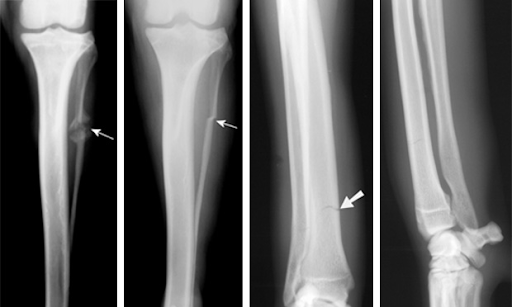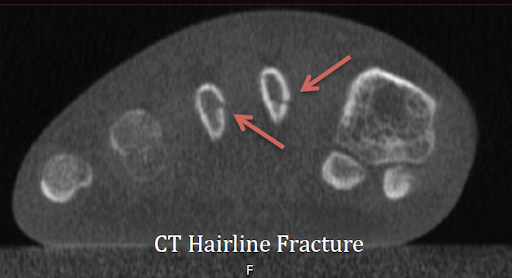What Is a Hairline Fracture? Causes, Symptoms, and Treatment Options
Not all injuries show themselves right away. Sometimes, even without swelling or bruising, a nagging pain lingers, especially after repetitive movements or a recent increase in physical activity.
You might brush it off as a minor sprain or overuse. But when the pain doesn’t go away, it’s worth considering a deeper cause. In many cases, this kind of ongoing discomfort turns out to be something like a hairline fracture.
In this blog, we will explain what hairline fractures are, what causes them, how to recognize the symptoms of a hairline fracture, and what treatments are available for a smooth recovery.
What is a Hairline Fracture?

Hairline fractures are usually caused due to repetitive trauma or overuse. A hairline fracture is an extremely small fracture that, at first, might not be seen on an X-ray, including in early stages.
Hairline fractures are most typically seen in sports where there are multiple repetitions or impacts on particular areas of the body, such as basketball, running, gymnastics and dance.
Risk Factors for Hairline Fractures
Certain risk factors increase your risk of developing hairline fractures:
- Gender: Women are at an increased risk for hairline fractures, especially if they have irregular menstrual cycles.
- Anatomical Concerns: Flat feet, high arches, or poor-quality shoes may potentially add extra stress to bones.
- Bone Health: Certain disease states, like osteoporosis, ultimately lead to weakened bones and an increased risk of fractures.
- History of Fractures: If someone had one hairline fracture in the past, it raises their risk of having additional hairline fractures in the future.
- Nutrition: A lack of calcium or vitamin D compromises bone strength, raising fracture risk.
What are the Causes of Hairline fractures?
Multiple things can lead to hairline fractures, which are as follows:
1. Repetitive Activity
Participating in a high-impact sport or repeatedly running can place excessive stress on the same bones over and over, and lead to microfracture injury.
2. Sudden Increase in Activity
Regularly living your normal lifestyle and suddenly beginning an aggressive exercise plan raises the chances of a fracture.
3. Improper Footwear
Using old or improper shoes (especially with high-impact exercise) can put too much stress on your foot and ankle bones.
4. Poor Nutrition
Not receiving enough calcium, vitamin D or calories makes them more prone to fractures.
5. Underlying Conditions
Osteoporosis or other conditions that deteriorate bone health can make bones more brittle, causing them to break with even the smallest amount of stress.
What are Hairline Fracture Symptoms?
Hairline fracture symptoms can be subtle at first and progress over time. They can often look like other soft tissue injuries that will require a diagnosis.
Watch for:
- Localized pain that intensifies through activity and diminishes with rest.
- Swelling or tenderness in the area of the injury.
- Some bruising.
- Difficulty bearing weight or completing certain movements.
- In the ankle or foot, observe a limp or an inability to walk comfortably.
- In the wrist or hand, notice weakness while gripping or lifting an object.
Common Hairline Fracture Areas and How to Identify Them
1. Hairline Fracture in Foot
Often called the metatarsal bones (top of the foot). Seen frequently with runners and athletes.
Symptoms: Pain on the top or side of the foot, especially while walking
Treatment: Rest, supportive shoes, or a walking boot
2. Hairline Fracture Ankle
The level of injury often depends on a sudden twist or repeated use. High-risk groups are runners and basketball players.
Symptoms: Sharp pain around the ankle joint, swelling
Treatment: elevate, ice, and partially immobilize with a boot or splint
3. Hairline Fracture Leg
It will often involve the tibia (shin bone), especially for long-distance runners or repeated jumpers.
Symptoms: dull pain, especially with pressure
Treatment: strict rest, anti-inflammatory medication, sometimes cast.
4. Hairline Fracture Knee
Usually rare, it occurs in the patella (kneecap) or femur (thigh bone).
Symptoms: restrictions in bending the knee, stiffness, pain with bending and walking
Treatment: consequential support and physical therapy post-rest period.
5. Hairline Fracture Wrist
Caused by an acute fall or constant use (e.g. weightlifting or typing).
Symptoms: Pain when using the wrist or applying pressure
Treatment: Displaced or non-displaced wrist splint or cast, and activity modification.
6. Hairline Fracture Hand
Most commonly seen in athletes or fall hacks, it will usually involve the metacarpal bones.
Symptoms: Pain when gripping or making a fist
Treatment: Immobilization using a splint or short cast
Diagnosis: Do You Need an X-ray?

Hairline fractures may be hard to detect on initial X-rays, especially in the first week after the injury. If a fracture is suspected but unconfirmed, physicians might recommend the following imaging with the understanding that for most bone injuries it will likely take time for swelling or changes that may suggest healing or otherwise to be indicated:
- MRI scan: best for soft tissues and identifying fractures early
- Bone scan: will show changes in bone metabolism
- CT scan: for complicated or deep fractures
So, if you have continued pain and are wondering if it’s a sprain, don’t disregard it.
Hairline Fracture Treatment Options
Are you anxious that your bothersome discomfort could be more than a sprain?
If you have been told that you have a hairline fracture, you may be wondering, “Do I need a cast? Will this heal by itself? When will I feel back to normal?”
Fortunately, most hairline fractures resolve quickly and with appropriate care. However, understanding what to do and not to do while you are recovering can be key. Below are safe and effective ways to treat a hairline fracture.
The treatment of a hairline fracture starts with R.I.C.E., which means Rest, Ice, Compression, and Elevation to help minimize swelling and prevent further damage.
Depending upon the location of the fracture, our specialists/ doctors may use splints, walking boots, and braces to immobilize the area. If the fracture is in the foot, ankle, or leg, crutches may be necessary to help keep all weight off the bone.
Pain management is typically done with over-the-counter NSAIDs like ibuprofen or paracetamol. Bone healing supplements such as calcium and vitamin D3 may also be recommended.
Once the fracture has healed initially, physical therapy is critical to regain strength and normal function. This is especially true in joints like the wrist, ankle, or knee.
Either way, with appropriate management, most hairline fractures heal completely in 6-8 weeks and do not require surgery.
Can You Walk on a Hairline Fracture?
It is possible, but not advisable. Putting pressure on a hairline fracture can aggravate the injury, slow healing, and turn a hairline fracture into a full fracture with complete damage. You should consult your medical professional and listen to their recommendations on weight-bearing and walking.
Does a Hairline Fracture need a plaster?
Not necessarily! Many hairline fractures are healed with a splint, walking boot, custom insoles, or even taping. Plaster is complicated and difficult to work with. Generally, plaster is used for fractures which are in a dangerous position for locations of movement during healing, such as the foot and ankle.
What Is the Difference between Hairline Fractures in Children versus Adults?
Hairline fractures can be vastly different from each age category. When thinking of children, they are still developing, and their bones are more flexible. As a result:
Some things to keep in mind:
- Their symptoms may not appear as drastic initially.
- Bones are likely to heal more rapidly, but attention must be given to assess the alignment or positioning of the bones as they heal. Especially if there is involvement of a growth plate.
With an adult or senior individual, there are a lot of complications:
- Bone density decreases with age throughout the lifespan, but especially after reaching menopause.
- Healing can take more time, with even the possibility of osteoporosis delaying the recovery period of the fracture.
- Adults tend to overlook the signs earlier on, as it is easier to dismiss an injury like that as a sprain or a pulled muscle.
Nutrition for Quicker Bone Healing: Foods to Eat (and Avoid)
While healing a hairline fracture requires rest, it also requires attention to your meals, with the right building blocks to repair bone tissue. There are many things to eat well, but three key categories of food are essential to bone repair:
Eat more:
- Calcium-rich foods: milk, yoghurt, tofu, sesame seeds, and leafy green vegetables
- Vitamin D: egg yolks, certain mushrooms, and sunshine
- Vitamin K2: Found in fermented foods like natto and aged cheese
- Magnesium and zinc: nuts and seeds, lentils, and whole grain foods
Avoid or limit:
- Caffeine: too much interferes with the absorption of calcium
- Sugary foods: increase inflammation, which can slow healing
- Alcohol and smoking: both inhibit bone formation, plus slow healing times
If you eat the right food, you will heal faster, but more importantly, you will lay the strongest foundation for your bones in the future.
Case Study: How MJ Naidu Hospital Supports Athletes & Active Lives?
Did you know stress fractures account for roughly 20% of all sports injuries, according to the Cleveland Clinic.
At MJ Naidu Super Speciality Hospital, we see the story behind every injury. We treat a wide range of sports-related conditions, from minor sprains to complex joint injuries, helping athletes and active individuals return to their routines stronger than before.
The Challenge?
The growing incidence of sports injuries affects not only professional athletes and serious competitors but also everyday fitness enthusiasts. These injuries range from hairline fractures and complex ligament tears, and can greatly affect the quality of life from both a physical and emotional standpoint.
What We Do?
While we provide outstanding orthopaedic care, we don’t forget the personal aspect of care! Our team is trained to:
✅Precisely diagnose injuries using advanced imaging (eg MRI, CT, digital X-ray) for effective treatment
✅Provide personalized experiments on numerous treatment options (eg physiotherapy, PRP therapy, bracing, surgery)
✅Provide emergency injury services 24/7 for injuries
We care for everything from ankle sprains, rotator cuff tears, and hairline fractures to the foot, ankle, or wrist, and with 24/7 trauma care, modern equipment, and one of Vijayawada’s most trusted orthopaedic teams, your recovery is in safe hands.
Final Thoughts
Hairline fractures might seem like a minor injury, but they can cause long-term pain if you don’t receive proper treatment and care for your injury.
It is important to identify symptoms early-on, learn how hairline fractures occur, and follow the treatment plan to heal quickly and fully.
At MJ Naidu Super Speciality Hospital, our expert panel of medical professionals are here to help you every step of the way, from reviewing treatment options to your full recovery.
If you are experiencing prolonged pain or think you may have a hairline fracture, visit us in person. We want to help you get back on your feet as fast as possible, stronger than ever and without pain.
Table of Contents
- What is a Hairline Fracture?
- Risk Factors for Hairline Fractures
- What are the Causes of Hairline fractures?
- What are Hairline Fracture Symptoms?
- Common Hairline Fracture Areas and How to Identify Them
- Diagnosis: Do You Need an X-ray?
- Hairline Fracture Treatment Options
- Can You Walk on a Hairline Fracture?
- Does a Hairline Fracture need a plaster?
- What Is the Difference between Hairline Fractures in Children versus Adults?
- Nutrition for Quicker Bone Healing: Foods to Eat (and Avoid)
- Final Thoughts

